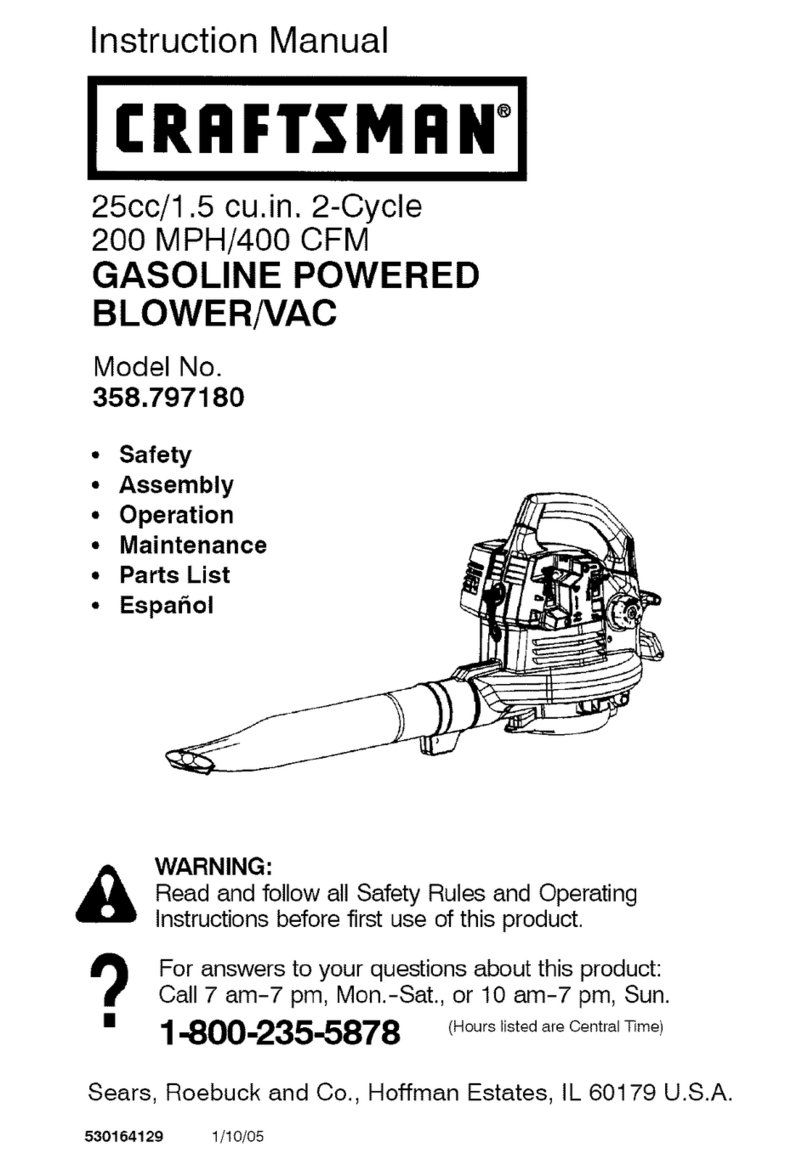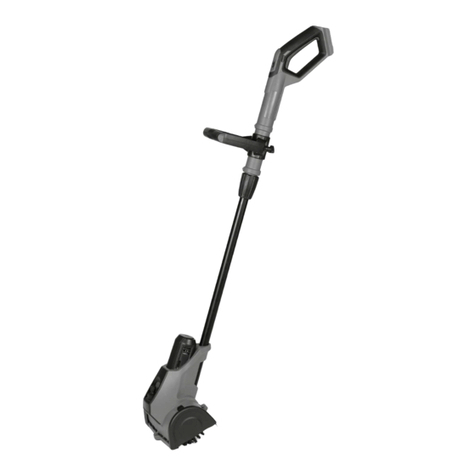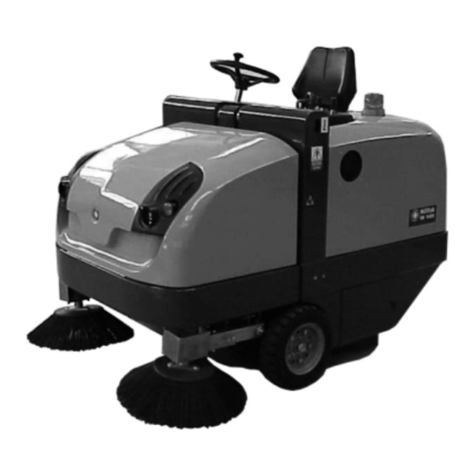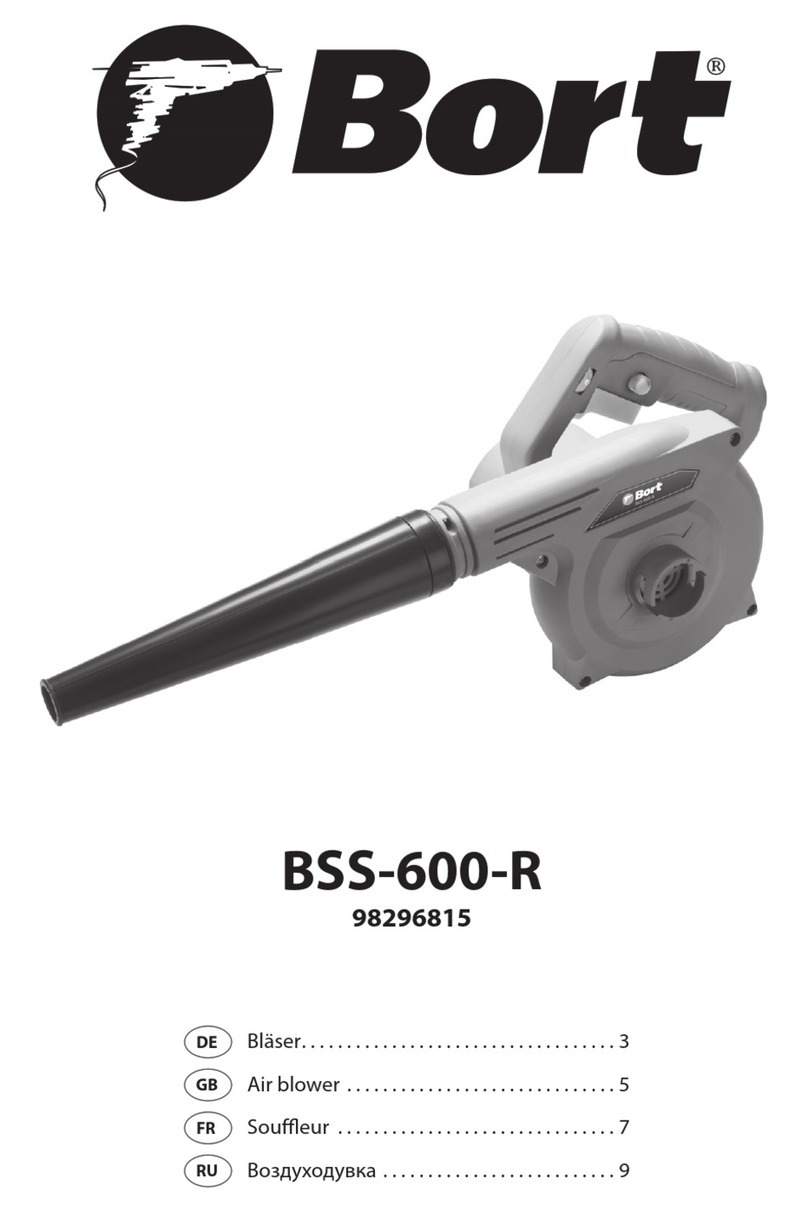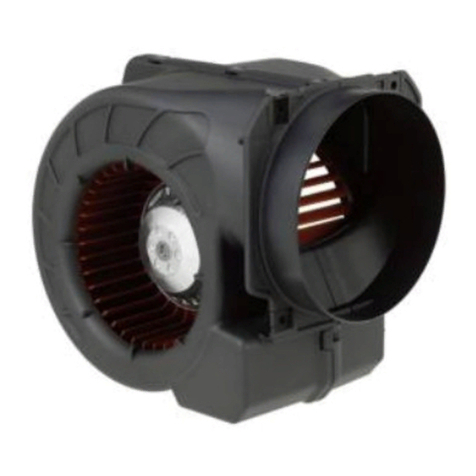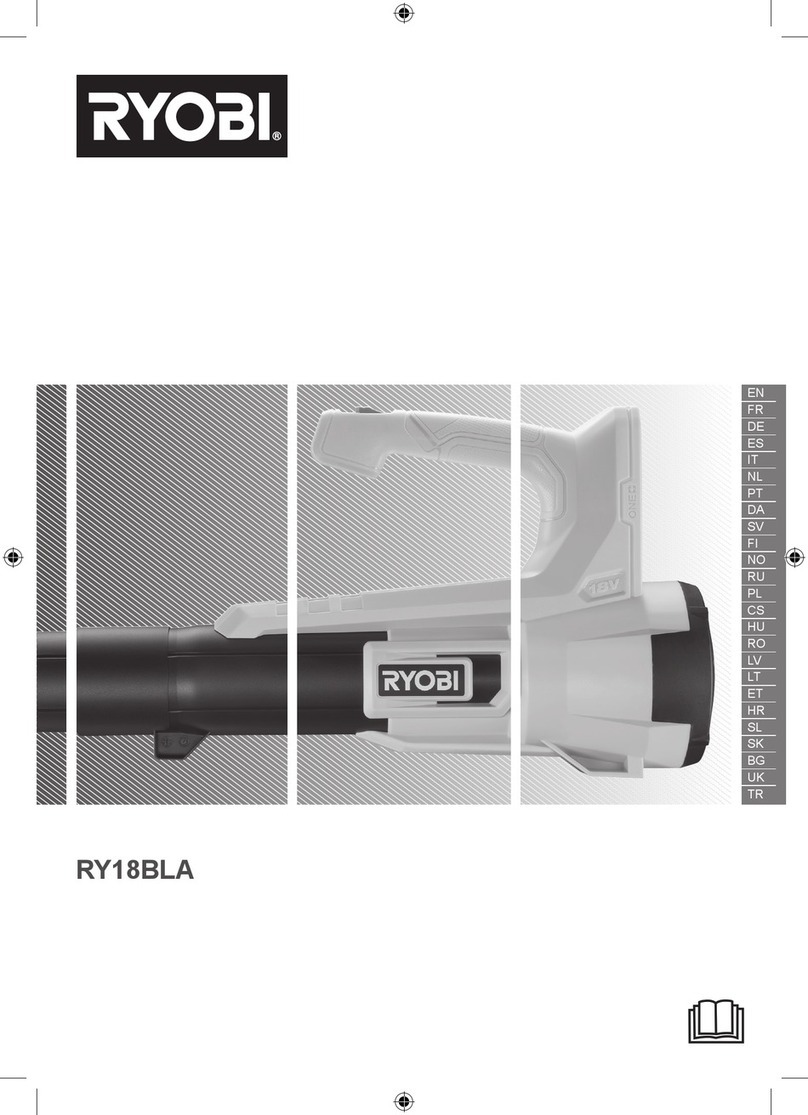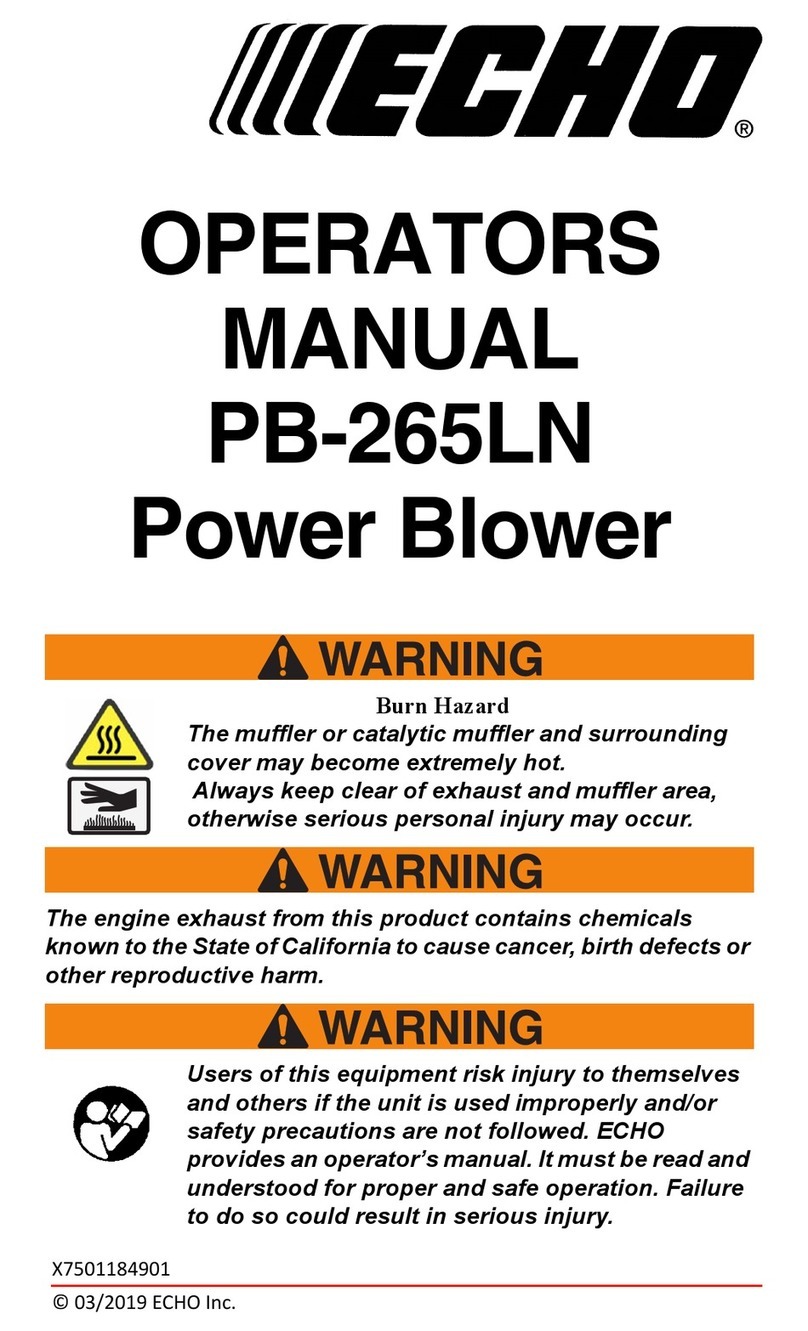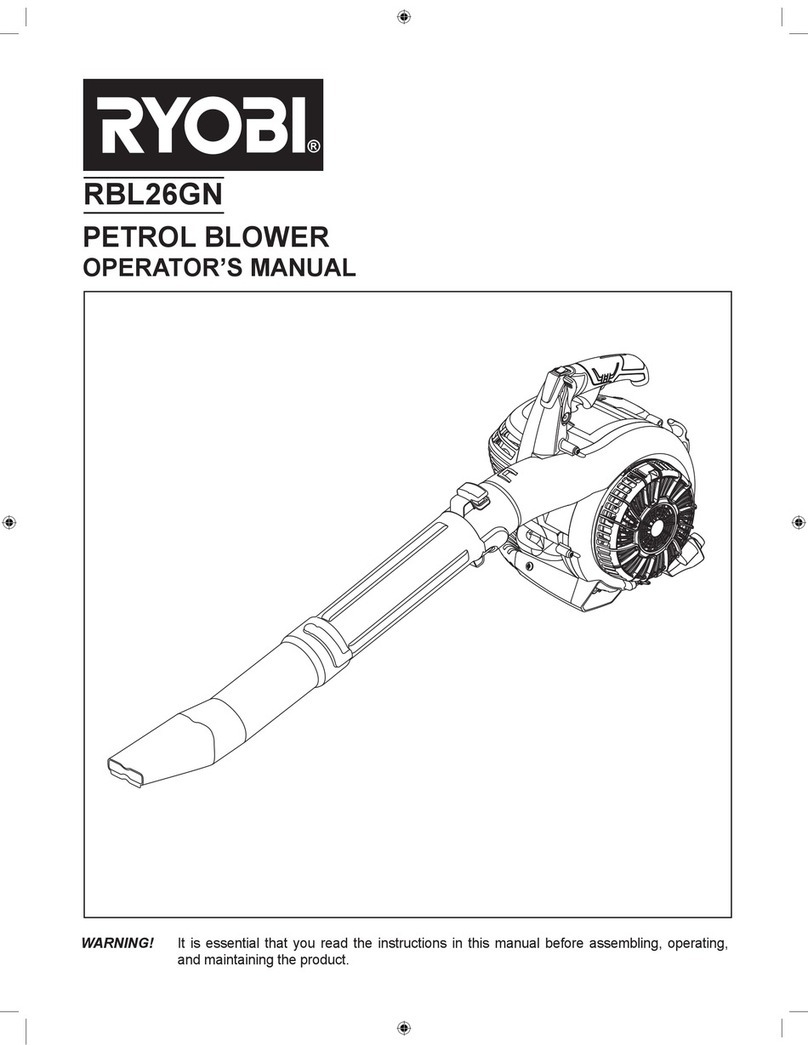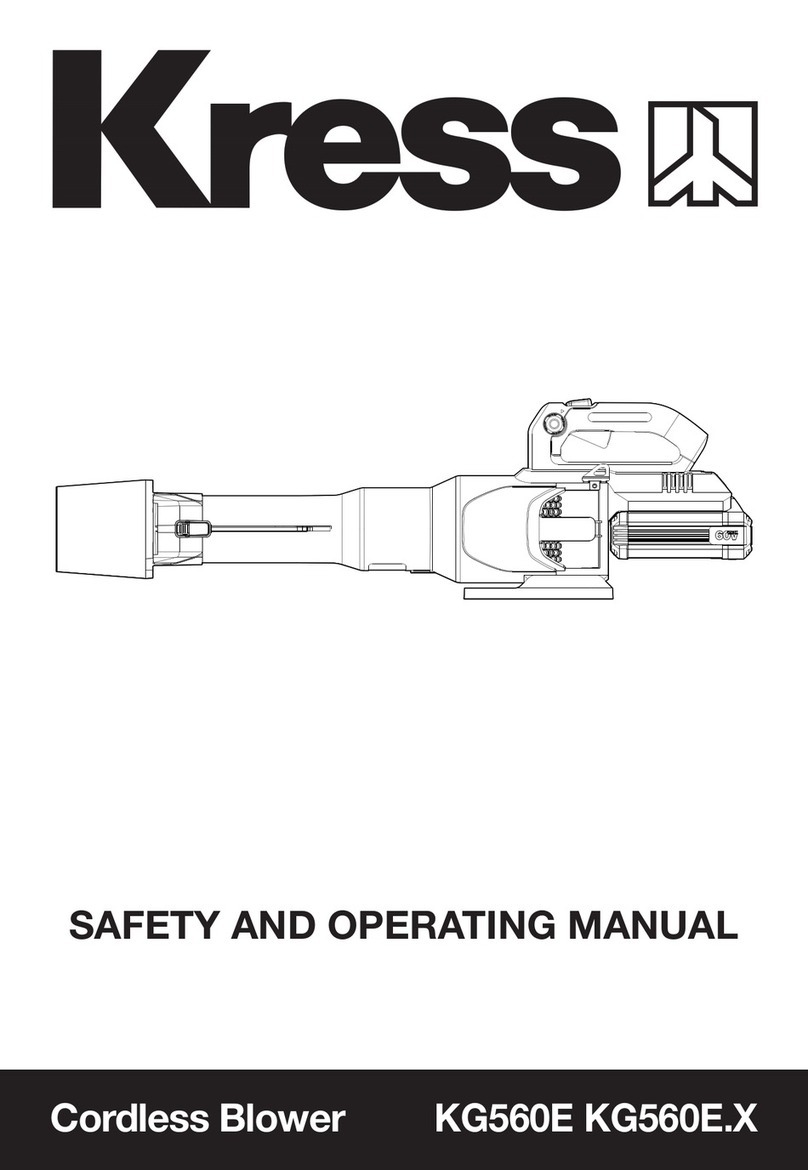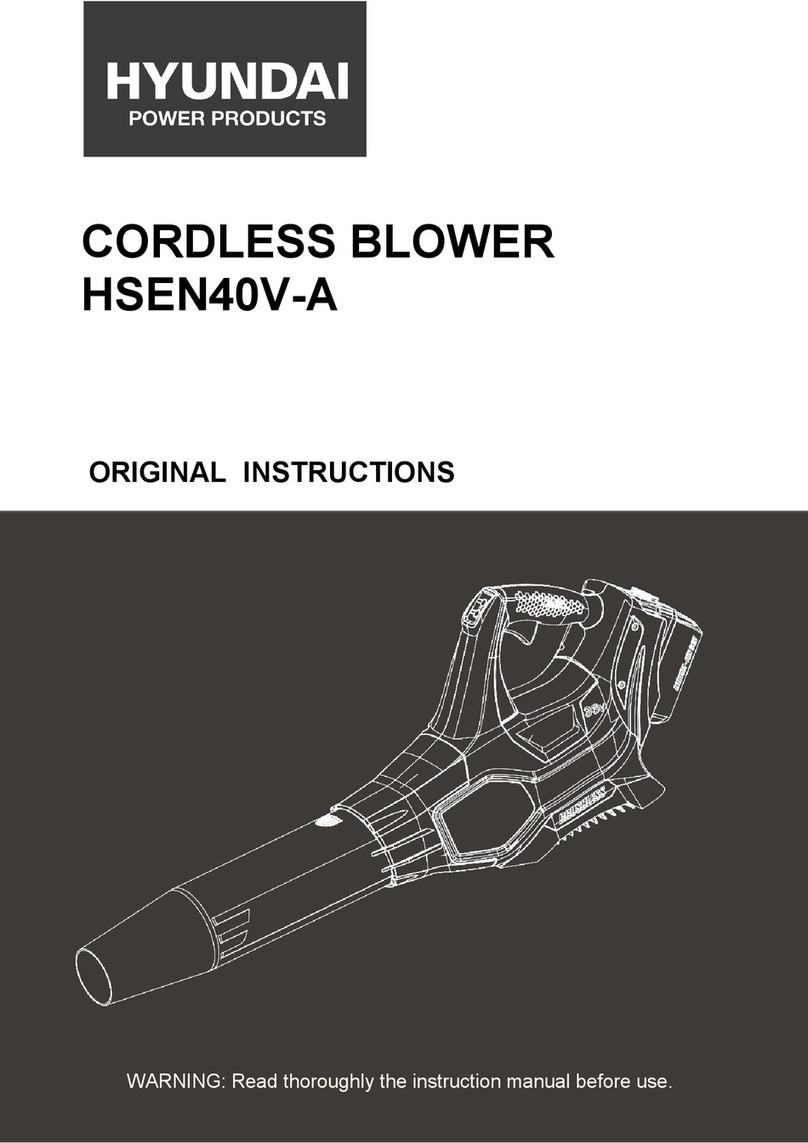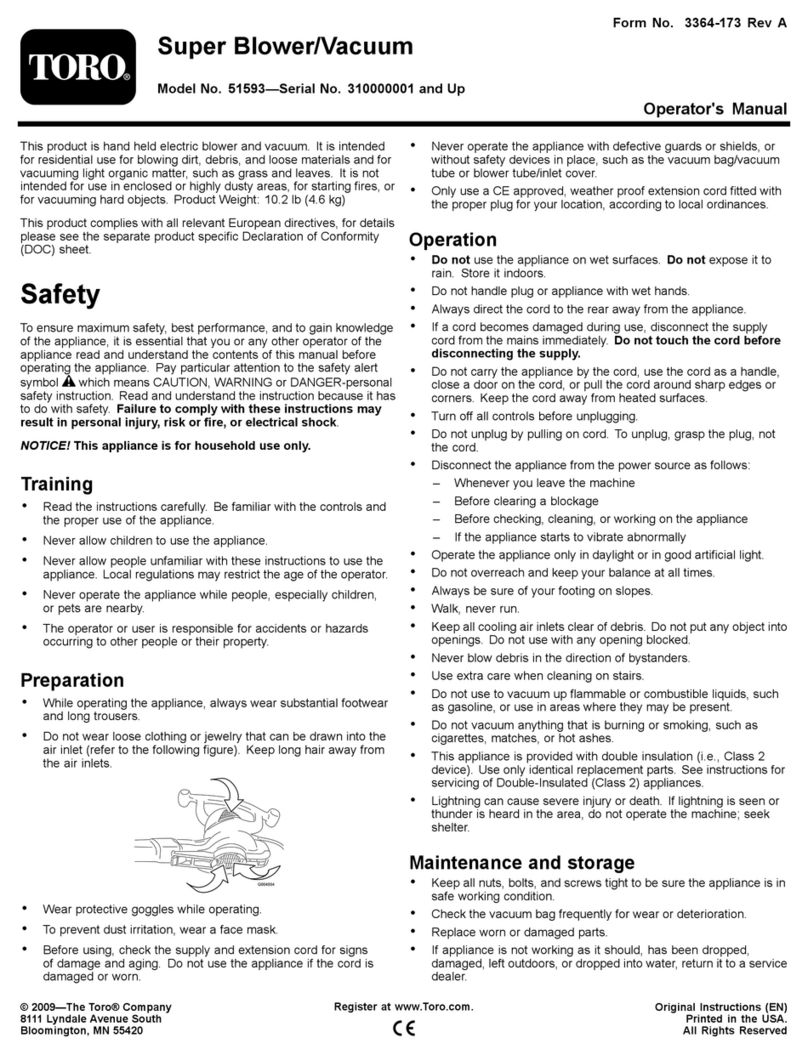Geotech BBV 260A User manual

Operator’s manual
GB (2 - 13)
FR (14 - 27)
DE (28 - 42)
Manuel d’utilisation
ES (43 - 56)
BBV 260A
Manual de instrucciones
Istruzioni per l’uso
Please read the operator’s manual carefully and make sure you understand the instructions before using the machine.
Lire attentivement et bien assimiler le manual d’utilisation avant d’utiliser la machine.
Lesen Sie die Bedienungsanweisung sorgfältig durch med und machen Sie sich mit dem Inhalt vertraut,
bevor Sie des Gerät benutzen.
Lea detenidament el manual de instrucciones y asegúrese de entender su contenido antes de utilizar la máquina.
Prima di usare la macchina, leggere per intero le istruzioni per l’uso e accertarsi di averne compreso il contenuto.
IT (57 - 70)
Bedienungsanweisung

-- 2 --
TABLE OF CONTENTS
Introduction 2
Identification of Symbols 3
General Safety Precautions 3
Identification (What is What?) 5
Assembly 6
Operation 8
Maintenance 10
Storage 12
Troubleshooting Table 12
Declaration of Conformity 13
Technical Data 13

-- 3 --
IDENTIFICATION OF SYMBOLS
Approved protective goggles
or visor, ear protection, and
face mask in dusty environments
must be worn.
The blower operator must make sure
that no bystanders or animals come
nearer than 15 metres.
Whenever several operators are
working in the same work area, they
should maintain a safe distance of at
least 15 meters from one another.
WARNING: The muffler is very
hot during and after use. Do not
touch the muffler, muffler guard, or
surrounding surfaces, or allow
combustible material such as dry
grass or fuel to do so.
Always wear approved,
protective gloves.
Instructions on how to open
vacuum inlet cover. Gently tilt
the handle of the screwdriver
toward the front of the unit to
release the latch while pulling
up on the vacuum inlet cover
with your other hand.
WARNING: This blower
can be dangerous! Careless
or improper use can
cause serious or even fatal
injury.
Read and understand the
instruction manual before
using the blower.
WARNING: Be sure the
bottom cover is secured or
the vacuum tube is properly
installed. Avoid the impeller
blade with your hand or any
foreign object.
Sound power
level
Use unleaded or quality
leaded petrol and two
stroke oil.
WARNING: The blower may throw
objects at high velocity that can
ricochet and hit the operator. This
may cause serious eye damage.
Sound pressure level
at 7,5 metres
When using the vacuum attachment, the
unit is designed to pick up dry material
such as leaves, grass, small twigs, and
bits of paper. Do not vacuum stones,
gravel, metal, broken glass, etc., to
avoid severe damage to the impeller.
GENERAL SAFETY PRECAUTIONS
WARNING: Failure to follow all
Safety Rules and Precautions can result in
serious injury.
KNOW YOUR UNIT
SRead your instruction manual carefully until
you completely understand and can follow all
warnings and safety rules before operating
the unit.
DRestrict unit to users who understand and will
follow all warnings and safety rules in this
manual.
WARNING: Inspect area before start-
ing unit. Remove all debris and hard objects
such as rocks, glass, wire, etc. that can rico-
chet, be thrown, or otherwise cause injury or
damage during operation.
WARNING: While vacuuming or
blowing debris, hold the unit with the muffler
side facing away from your body and clothes.
Use your unit as a blower for:
DSweeping debris or grass clippings from
driveways, sidewalks, patios, etc.
DBlowing grass clippings, straw, or leaves into
piles, around joints, or between bricks.
Use your unit as a vacuum for:
DPicking up dry material such as leaves, grass,
small twigs, and bits of paper.
DFor best results during vacuum use, operate
your unit at high speed.
DMove slowly back and forth over the material
as you vacuum. Avoid forcing the unit into a
pile of debris as this can clog the unit.
DKeep the vacuum tube about an inch above
the ground for best results.

-- 4 --
GENERAL SAFETY PRECAUTIONS
PLAN AHEAD
WARNING: This machine produces
an electromagnetic field during operation. Under
some circumstances, this field may interfere
with active or passive medical implants. To re-
duce the risk of serious or fatal injury, we recom-
mend persons with medical implants to consult
their physician and the medical implant
manufacturer before operating this machine.
DAlways wear eye and ear protection when
operating, servicing, or performing
maintenance on unit. Wearing eye protection
will help to prevent rocks or debris from being
blown or ricocheting into eyes and face which
can result in blindness and/or serious injury.
Eye protection should be marked Z87.
DAlways wear foot protection. Do not go
barefoot or wear sandals.
DAlways wear respirator or face mask when
working with unit in dusty environments.
DSecure hair above shoulder length. Secure or
remove jewelry, loose clothing, or clothing
with loosely hanging straps, ties, tassels, etc.
They can be caught in moving parts.
DDo not operate unit when you are tired, ill,
upset, or if you are under the influence of
alcohol, drugs, or medication.
DKeep children, bystanders, and animals away
from work area a minimum of 15 meters when
starting or operating unit. Do not point blower
nozzle in the direction of people or pets.
HANDLE FUEL WITH CAUTION
DEliminate all sources of sparks or flame
(including smoking, open flames, or work that
can cause sparks) in the areas where fuel is
mixed, poured, or stored.
DMix and pour fuel in an outdoor area; store
fuel in a cool, dry, well ventilated place; use an
approved, marked container for all fuel
purposes.
DDo not smoke while handling fuel or while
operating the unit.
DMake sure the unit is properly assembled and
in good operating condition.
DDo not fill fuel tank while engine is hot or
running.
DAvoid spilling fuel or oil. Wipe up fuel spills
before starting engine.
DMove at least 3 meters away from fuel and
fueling site before starting engine.
DAlways store petrol in a container approved
for flammable liquids.
OPERATE YOUR UNIT SAFELY
WARNING: Stop the engine before
opening the vacuum inlet door. The engine
must be stopped and the impeller blades no
longer turning to avoid serious injury from the
rotating blades.
WARNING: While vacuuming or
blowing debris, hold the unit with the muffler
side facing away from your body and clothes.
DThis garden blower/vacuum is only designed
for blowing away or removal of leaves and
other debris on the ground.
DInspect unit before each use for worn, loose,
missing, or damaged parts. Do not use until
unit is in proper working order.
DKeep outside surfaces free of oil and fuel.
DNever start or run engine inside a closed
room or building. Breathing exhaust fumes
can kill.
DMufflers fitted with catalytic converters get
very hot during use and remain so for some
time after stopping. This also applies at idle
speed. Contact can result in burns to the skin.
Remember the risk of fire!
DTo avoid static electricity shock, do not wear
rubber gloves or any other insulated gloves
while operating unit.
DDo not set unit on any surface except a
clean, hard area while engine is running.
Debris such as gravel, sand, dust, grass,
etc. could be picked up by the air intake and
thrown out through discharge opening,
damaging unit, property, or causing serious
injury to bystanders or operator.
DAvoid dangerous environments. Do not use in
unventilated areas or where explosive vapors
or carbon monoxide build up could be
present.
DDo not overreach or use from unstable
surfaces such as ladders, trees, steep
slopes, rooftops, etc. Keep firm footing and
balance at all times.
DNever place objects inside the blower tubes;
always direct the blowing debris away from
people, animals, glass, and solid objects such
as trees, automobiles, walls, etc. The force of
air can cause rocks, dirt, or sticks to be
thrown or to ricochet which can hurt people or
animals, break glass, or cause other damage.
DNever run unit without the proper equipment
attached. When using your unit as a blower,
always install blower tubes. When using your
unit as a vacuum, always install vacuum
tubes and vacuum bag assembly. Make sure
vacuum bag assembly is completely zipped.
DCheck air intake opening, blower tubes,
vacuum tubes, and elbow tube frequently,
always with engine stopped and spark plug
disconnected. Keep vents and discharge
tubes free of debris which can accumulate
and restrict proper air flow.
DNever place any object in the air intake
opening as this could restrict proper air flow
and cause damage to the unit.
DNever use for spreading chemicals, fertilizers,
or other substances which may contain toxic
materials.
DTo avoid spreading fire, do not use near leaf or
brush fires, fireplaces, barbecue pits,
ashtrays, etc.
DUse only for jobs explained in this manual.
MAINTAIN YOUR UNIT PROPERLY
DHave all maintenance other than the
recommended procedures described in the
instruction manual performed by an
authorized service dealer.

-- 5 --
GENERAL SAFETY PRECAUTIONS
D
D
D
D
D
D
D
Disconnect spark plug before performing
maintenance except for carburetor
adjustments.
Use only recommended replacement
parts; use of any other parts may void
your warranty and cause damage to your unit.
Empty fuel tank before storing the unit. Use
up fuel left in carburetor by starting engine and
letting it run until it stops.
Do not use any accessory or attachment
other than those recommended by
manufacturer for use with your unit.
Do not store the unit or fuel in a closed area
where fuel vapors can reach sparks or an
open flame from hot water heaters, electric
motors or switches, furnaces, etc.
Store in a dry area out of reach of children.
Secure the machine during transport.
SAFETY NOTICE: Exposure to vibrations
through prolonged use of gasoline powered
hand tools could cause blood vessel or nerve
damage in the fingers, hands, and joints of peo-
ple prone to circulation disorders or abnormal
swelling. Prolonged use in cold weather has
been linked to blood vessel damage in other-
wise healthy people. If symptoms occur such as
numbness, pain, loss of strength, change in skin
color or texture, or loss of feeling in the fingers,
hands, or joints, discontinue the use of this tool
and seek medical attention. An antivibration
system does not guarantee the avoidance of
these problems. Users who operate power tools
on a continual and regular basis must monitor
closely their physical condition and the condition
of this tool.
IDENTIFICATION (WHAT IS WHAT?)
1. Throttle trigger 10. Lower blower tube
2. STOP switch 11. High--speed nozzle
3. Primer button 12. Elbow tube
4. Start lever 13. Vacuum bag
5. Fuel cap 14. Upper vacuum tube
6. Starter rope 15. Lower vacuum tube
7. Vacuum handle 16. Throttle position lever
8. Spark plug 17. Instruction manual
9. Upper blower tube
WHAT IS WHAT?
17
14
12
15
10
11
9
8
2
1
6
3
5
16
4
7
13
MANUAL

-- 6 --
ASSEMBLY
CARTON CONTENTS
Check carton contents against the following list.
SBlower
SUpper blower tube
SLower blower tube
SHigh velocity nozzle
SElbow tube
SVacuum bag
SUpper vacuum tube
SLower vacuum tube
SScrew for vacuum tube assembly
NOTE: It is normal for the fuel filter to rattle
in the empty fuel tank.
ASSEMBLY
WARNING: Stop engine and be sure
the impeller blades have stopped turning be-
fore opening the vacuum inlet door or at-
tempting to insert or remove the vacuum or
blower tubes. The rotating blades can cause
serious injury. Always disconnect the spark
plug before performing maintenance or ac-
cessing movable parts.
WARNING: If received assembled,
repeat all steps to ensure your unit is properly
assembled and all fasteners are secure. Fol-
low all safety information in the manual and on
the unit.
DA standard screwdriver is required for as-
sembly.
BLOWER ASSEMBLY
BLOWER TUBE ASSEMBLY
1. Align the rib on the upper blower tube with
the groove in the blower outlet; slide the
tube into place.
NOTE: The tube clamp bolt must be loose
enough to allow blower tube to be inserted in
blower outlet. Loosen the bolt by turning coun-
terclockwise (do not remove nuts).
Blower Outlet
Rib
Groove
2. Secure the tube by turning the bolt clock-
wise.
3. Align the slots on the lower blower tube
with the tabs on the upper blower tube.
Upper Blower Tube
Tab
Lower Blower Tube
Slot
Tube clamp
bolt and nut
4. Slide the lower blower tube onto the upper
blower tube.
5. Turn the lower blower tube clockwise until
a click is felt to secure the lower blower
tube to the upper blower tube.
NOTE: When the upper and lower blower
tubes are assembled together properly, the
arrows on both tubes will be aligned.
6. To remove the tubes, turn the bolt counter-
clockwise to loosen the tubes (do not
remove nuts); remove the tubes.
HIGH--SPEED NOZZLE ASSEMBLY
When greater air speed is desired, use the
high--speed nozzle.
1. Align the slots on the nozzle with the tabs
on the lower blower tube.
High--Spee
d
Nozzle
Tab Slot
Lower Blower
Tube
2. Slide the nozzle onto the lower blower tube.
3. Turn the nozzle clockwise until a click is
felt to secure the nozzle to the lower blow-
er tube.
VACUUM ASSEMBLY
VACUUM BAG ASSEMBLY
1. Open the zipper on the vacuum bag and
insert the elbow tube.
2. Push the small end of the elbow tube
through the small opening in the bag.
Small Opening
Zipper
Opening
Elbow
Tube Rib
NOTE: Make sure edge of the small open-
ing is flush against the flared area of the el-
bow tube, and the rib on the elbow tube is
on the bottom.
3. Close the zipper on the bag. Make sure the
zipper is closed completely.
4. Remove blower tubes from engine.

-- 7 --
ASSEMBLY
Rib
Groove
5. Insert the elbow tube into the blower outlet.
Make sure elbow tube rib is aligned with
the blower outlet groove.
6. Turn knob clockwise to secure elbow tube.
VACUUM TUBE ASSEMBLY
WARNING: Stop engine and be sure
the impeller blades have stopped turning be-
fore opening the vacuum inlet door or at-
tempting to insert or remove the vacuum or
blower tubes. The rotating blades can cause
serious injury.
1. Insert the tip of a screwdriver into the latch
area of the vacuum inlet.
Latch
Area
Blower
Outlet
Latch Area
Vacuum Inlet Cover
2. Gently tilt the handle of the screwdriver to-
ward the front of the unit to release the
latch while pulling up on the vacuum inlet
cover with your other hand.
3. Hold the vacuum inlet cover open until up-
per vacuum tube is installed.
V
acuu
m
Inlet
Cover
Vacuum
Inlet
4. Align the tabs on theinside of the vacuum in-
let with the slots on the upper vacuum tube.
Tab Slot
5. Push the upper vacuum tube into the vac-
uum inlet. Turn the tube counterclockwise
until a click is felt to secure the tube to the
blower unit.
6. Align slanted end of lower vacuum tube as
shown. Push lower vacuum tube into upper
vacuum tube until the lower tube is securely
seated in the upper tube (about 7 cm).
Slanted end of
lower vacuum tube
7. When vacuum tubes are fitted together,
locate the label on the lower portion of the
upper tube. Permanently assemble the two
tubes together with the supplied screw.
Upper
Vacuum
Tube
Lower
Vacuum
Tube
HOW TO CONVERT UNIT FROM
VACUUM USE TO BLOWER USE
WARNING: While blowing debris,
hold the unit with the muffler side facing away
from your body and clothes (see OPERAT-
ING POSITION).
1. Remove the elbow tube and vacuum bag
by turning the knob counterclockwise to
loosen the elbow tube.
2. Remove the vacuum tubes by turning the
tubes clockwise.

-- 8 --
ASSEMBLY
3. Close the vacuum inlet cover and make
sure it is latched closed.
4. Reinstall the blower tubes (see BLOWER
TUBE ASSEMBLY).
SHOULDER STRAP ADJUSTMENT
WARNING: While vacuuming debris,
hold the unit with the muffler side facing away
from your body and clothes (see OPERAT-
ING POSITION).
2. Pass the shoulder strap over your head
and onto your left shoulder.
3. Extend your right arm toward the rear of
the vacuum bag.
4. Adjust shoulder strap until the vacuum
bag/shoulder strap seam lies between
your thumb and index finger.
5. Make sure air flows freely from the elbow
tube into bag. If bag is kinked, the unit will
not operate properly.
OPERATION
OPERATING POSITION
Blower Vacuum
Hearing Protection
Eye
Protection
Hearing Protection
OPERATING TIPS
WARNING: While vacuuming or
blowing debris, hold the unit with the muffler
side facing away from your body and clothes
(see OPERATING POSITION).
STo reduce the risk of hearing loss
associated with sound level(s), hearing
protection is required.
STo reduce the risk of injury associated with
contacting rotating parts, stop the engine be-
fore installing or removing attachments. Do
not operate without guard(s) in place.
SOperate power equipment only at reasonable
hours--not early in the morning or late at night
when people might be disturbed. Comply with
times listed in local ordinances. Usual recom-
mendations are 9:00 a.m. to 5:00 p.m.,
Monday though Saturday.
STo reduce noise levels, limit the number of
pieces of equipment used at any one time.
STo reduce noise levels, operate power
blowers at the lowest possible throttle
speed to do the job.
SUse rakes and brooms to loosen debris be-
fore blowing.
SIn dusty conditions, slightly dampen sur-
faces or use a mister attachment when wa-
ter is available.
SConserve water by using power blowers
instead of hoses for many lawn and garden
applications, including areas such as gutters,
screens, patios, grills, porches, and gardens.
SWatch out for children, pets, open windows,
or freshly washed cars. Blow debris away
safely.
SUse the full blower nozzle extension so the
air stream can work close to the ground.
SAfter using blowers and other equipment,
CLEAN UP! Dispose of debris in trash re-
ceptacles.
BEFORE STARTING ENGINE
WARNING: Be sure to read the fuel
information in the safety rules before you
begin. If you do not understand the safety
rules, do not attempt to fuel your unit. Contact
an authorized service dealer.
FUELING ENGINE
WARNING: Remove fuel cap slowly
when refueling.
This engine is certified to operate on unleaded
petrol. Before operation, petrol must be mixed
with a good quality 2--cycleair--cooled engine oil
designed to be mixed at a ratio of 40:1. A 40:1
ratio is obtained by mixing 5 liters of unleaded
petrol with 0,125 liter of oil. DO NOT USE
automotive oil or marine oil. These oils will
cause engine damage. When mixing fuel, follow

-- 9 --
OPERATION
instructions printed on oil container. Once oil is
added to petrol, shake container momentarily to
assure that the fuel is thoroughly mixed. Always
read and follow the safety rules relating to fuel
before fueling your unit.
MIXING RATIO
Petrol, litre Two--stroke oil, litre
40:1 (2,5%)
2 0,050
5 0,125
10 0,250
CAUTION: Never use straight petrol in your
unit. This will cause permanent engine
damage.
FUEL REQUIREMENTS
Use good quality unleaded petrol. The lowest
recommended octane grade is 90 (RON).
IMPORTANT
Use of alcohol blended fuels (more than 10%
alcohol) can cause major engine performance
and durability problems.
WARNING: Incorrect use of fuel and/
or lubricants will cause problems such as:
improper clutch engagements, overheat-
ing, vapor lock, power loss, lubrication defi-
ciency, deterioration of fuel lines, gaskets
and internal carburetor components, etc.
Alcohol blended fuels will cause a high ab-
sorption of moisture in the fuel/oil mixture,
causing the separation of oil and fuel.
HOW TO STOP YOUR ENGINE
SRelease the throttle trigger.
SPush and hold the STOP switch in the
STOP position until the engine stops.
BEFORE STARTING THE ENGINE
WARNING: You MUST make sure the
tubes are secure before using the unit.
DFuel engine. Move at least 3 meters away
from the fueling site.
DHold the unit in the starting position as
shown. Make sure the blower end is di-
rected away from people, animals, glass,
and solid objects.
Blower
Vacuum
STARTING POSITION
WARNING: When starting engine,
hold the unit as illustrated. Do not set unit on
any surface except a clean, hard area when
starting engine or while engine is running. De-
bris such as gravel, sand, dust, grass, etc.
could be picked up by the air intake and
thrown out through the discharge opening,
damaging the unit or property, or causing seri-
ous injury to bystanders or the operator.
STARTING A COLD ENGINE (or a
warm engine after running out of fuel)
1. Move the throttle position lever to the idle
position.
Throttle
Position
Lever
2. Slowly press the primer bulb 6 times.
3. Move the start lever to the START position.
Start
Lever
Starter
Handle
Primer
Bulb

-- 10 --
OPERATION
4. Pull starter rope handle sharply 5 times (no
more than 3 times above 32°C/90°F). If en-
gine starts and runs prior to 5 pulls, allow en-
gine to run for 5 seconds; then, fully squeeze
the throttle trigger to disengage the starting
system (start lever returns to RUN position).
Steps 5 and 6 are not necessary.
5. Fully squeeze the throttle trigger to disen-
gage the starting system (start lever returns
to RUN position).
6. Pull starter rope handle sharply while
squeezing throttle trigger until engine starts
and runs.
There is a simplified start reminder (with
illustrations to describe each step) loc-
ated on the back of the blower.
STARTING A WARM ENGINE
1. Squeeze and hold the throttle trigger.
2. Pull starter rope handle sharply while
squeezing throttle trigger until engine starts
and runs.
NOTE: Normally, the warm starting proce-
dure can be used within 5--10 minutes after
the unit is turned off. If the unit sits for more
than 10 minutes without being used, it will be
necessary to start the unit by following the
steps under STARTING A COLD ENGINE or
following the starting instruction steps shown
on the unit.
STARTING A FLOODED ENGINE
Flooded engines can be started by moving the
start lever to the RUN position and fully
squeezing the throttle trigger. Pull the starter
handle repeatedly while squeezing throttle
trigger until engine starts and runs. This could
require pulling the starter handle many times,
depending on how badly the unit is flooded. If
the unit still doesn t start, refer to the TROU-
BLESHOOTING TABLE.
MAINTENANCE
WARNING: Avoid touching muffler
unless engine and muffler are cold. A hot
muffler can cause serious burns.
WARNING: Disconnect the spark
plug before performing maintenance except
for carburetor adjustments.
CHECK FOR LOOSE
FASTENERS AND PARTS
SMuffler
SSpark Plug Boot
SAir Filter
SHousing Screws
CHECK FOR DAMAGED OR
WORN PARTS
Contact an authorized service dealer for re-
placement of damaged or worn parts.
SFuel Tank. Discontinue use of unit if fuel
tank is damaged or leaks.
SVacuum Bag -- Discontinue use of vacuum
bag if it is torn or damaged.
INSPECT AND CLEAN UNIT & LABELS
SAfter each use, inspect complete unit for
loose or damaged parts. Clean the unit and
decals using a damp cloth with a mild deter-
gent.
SWipe off unit with a clean dry cloth.
CLEAN AIR FILTER
Air Filter Cover
Air Filter
Button
A dirty air filter decreases engine perform-
ance and increases fuel consumption and
harmful emissions. Always clean after every
5 hours of operation or yearly, whichever
comes first.
1. Clean the cover and the area around it to
keep debris from falling into the carburetor
chamber when the cover is removed.
NOTE: Move choke lever to RUN position
before opening air filter cover.
2. Remove parts as illustrated.
NOTE: Do not clean filter in gasoline or
other flammable solvent. Doing so can
create a fire hazard or produce harmful
evaporative emissions.
3. Wash the filter in soap and water.
4. Allow filter to dry.
5. Apply a few drops of oil to the filter;
squeeze filter to distribute oil.
6. Replace parts.

-- 11 --
MAINTENANCE
REPLACE SPARK PLUG
Replace spark plug each year to ensure the
engine starts easier and runs better. Set
spark plug gap at 0.6 mm. Ignition timing is
fixed, nonadjustable.
1. Twist, then pull off spark plug boot.
2. Remove spark plug from cylinder and dis-
card.
3. Replace with Champion RCJ-6Y spark
plug and tighten securely with a 19 mm
socket wrench.
4. Reinstall the spark plug boot.
REPLACE FUEL FILTER
To replace fuel filter, drain unit by running it dry of
fuel, then remove fuel cap/retainer assembly
from tank. Pull filter from tank and remove it from
fuel line. Install new fuel filter on fuel line; reinstall
parts.
Fuel Line
Fuel Filter
CHECK MUFFLER MOUNTING
SCREWS
Once each year, ensure muffler mounting
screws are secure and tightened properly to
prevent damage.
Muffler
Mounting Screw
CARBURETOR ADJUSTMENTS
The carburetor has been carefully set at the
factory. Adjustments may be necessary if you
notice any of the following conditions:
SEngine will not idle when the throttle is re-
leased.
Idle Speed Adjustment
Allow engine to idle. Adjust speed until engine
runs without stalling (idle speed too slow).
STurn idle speed screw clockwise to in-
crease engine speed if engine stalls or dies.
STurn idle speed screw counterclockwise to
decrease engine speed.
Air
Filter
Cover
Idle Speed Screw
If you require further assistance or are unsure
about performing this procedure, contact an
authorized service dealer.

-- 12 --
STORAGE
WARNING: Prepare unit for storage at
end of season or if it will not be used for 30 days
or more.
SAllow engine to cool, and secure the unit be-
fore storing or transporting.
SStore unit and fuel in a well ventilated area
where fuel vapors cannot reach sparks or
open flames from water heaters, electric mo-
tors or switches, furnaces, etc.
SStore unit with all guards in place. Position unit
so that any sharp object cannot accidentally
cause injury.
SStore unit and fuel well out of thereach of chil-
dren.
EXTERNAL SURFACES
SIf your unit is to be stored for a period of time,
clean it thoroughly before storage. Store in a
clean dry area.
SLightly oil external metal surfaces.
INTERNAL ENGINE
SRemove spark plug and pour 1 teaspoon of
2-cycle engine oil (air cooled) through the
spark plug opening. Slowly pull the starter
rope 8 to 10 times to distribute oil.
SReplace spark plug with new one of recom-
mended type and heat range.
SClean air filter.
SCheck entire unit for loose screws, nuts, and
bolts. Replace any damaged, broken, or worn
parts.
SStart each season using only fresh fuel hav-
ing the proper gasoline to oil ratio.
OTHER
SDo not store gasoline from one season to
another.
SReplace your gasoline can if it starts to rust.
1.See “Fueling Your Unit.”
2.Replace with correct spark plug.
3.Contact an authorized service dealer.
4.Contact an authorized service dealer.
TROUBLE CAUSE REMEDY
Engine will not
start.
1.Engine flooded.
2.Fuel tank empty.
3.Spark plug not firing.
4.Fuel not reaching carburetor.
5.Compression low.
1.See “Starting Instructions.”
2.Fill tank with correct fuel mixture.
3.Install new spark plug.
4.Check for dirty fuel filter; replace.
Check for kinked or split fuel line;
repair or replace.
5.Contact an authorized service dealer.
Engine will not
idle properly.
1.Fuel not reaching carburetor.
2.Carburetor requires adjustment.
3.Crankshaft seals worn.
4.Compression low.
1.Check for dirty fuel filter; replace.
Check for kinked or split fuel line;
repair or replace.
2.Contact an authorized service dealer.
3.Contact an authorized service dealer.
4.Contact an authorized service dealer.
1.Air filter dirty.
2.Fuel not reaching carburetor.
3.Spark plug fouled.
4.Spark arresting screen clogged.
5.Carburetor requires adjustment.
6.Carbon build up.
7.Compression low.
Engine will not
accelerate,
lacks power, or
dies under a
load.
1.Clean or replace air filter.
2.Check for dirty fuel filter; replace.
Check for kinked or split fuel line;
repair or replace.
3.Clean or replace spark plug; re-gap.
4.Replace screen.
5.Contact an authorized service dealer.
6.Contact an authorized service dealer.
7.Contact an authorized service dealer.
Engine
smokes
excessively.
1.Choke partially on.
2.Fuel mixture incorrect.
3.Air filter dirty.
4.Carburetor requires adjustment.
1.Adjust choke.
2.Empty fuel tank and refill with
correct fuel mixture.
3.Clean or replace air filter.
4.Contact an authorized service dealer.
Engine
runs hot.
1.Fuel mixture incorrect.
2.Spark plug incorrect.
3.Carburetor requires adjustment.
4.Carbon build up.
TROUBLESHOOTING TABLE
WARNING: Always stop unit and disconnect spark plug before performing any of the
recommended remedies below other than remedies that require operation of the unit.

-- 13 --
TECHNICAL DATA
25
0,75
2800
Champion RCJ--6Y
0,6
540
4,4
MODEL: BBV 260A
ENGINE
Engine displacement, cm3
Maximum Engine Power, according to ISO 8893, kW
Idle Speed +/-- 200, rpm
IGNITION SYSTEM
Spark plug
Electrode gap, mm
FUEL AND LIBRICATION SYSTEM
Fuel tank capacity, cm3
WEIGHT
Weight without fuel and tubes, kg
NOISE EMISSIONS
(see Note 1)
Sound power level, measured dB(A)
103,9
Sound power level, guaranteed LWA dB(A) 108,0
SOUND LEVELS
(see Note 2)
Equivalent sound pressure level at the operator s ear, measured
according to ISO 22868, dB(A)
Equipped with blower tubes and nozzle (original) 96,7
Equipped with vacuum tubes (original) 98,6
VIBRATION LEVELS
(see Note 3)
Equivalent vibration levels (ahv,eq) at handles, measured
according to ISO 22867, m/s2
Equipped with blower tubes and nozzle (original), right 10,1
Equipped with vacuum tubes (original), left/right 8,2/10,4
Note 1: Noise emissions in the environment measured as sound power (LWA) in conformity
with EC directive 2000/14/EC. Reported sound power level for the machine has been mea-
sured with the original cutting attachment that gives the highest level. The difference between
guaranteed and measured sound power is that the guaranteed sound power also includes
dispersion in the measurement result and the variations between different machines of the
same model according to Directive 2000/14/EC.
Note 2: Reported data for equivalent sound pressure level for the machine has a typical
statistical dispersion (standard deviation) of 1 dB(A).
Note 3: Reported data for equivalent vibration level has a typical statistical dispersion (stan-
dard deviation) of 1 m/s2.

-- 14 --
TABLE DES MATIÈRES
Introduction 14
Explication des symboles 15
Instructions générales de sécurité 15
Description des pièces 18
Montage 18
Fonctionnement 21
Entretien 23
Rangement 25
Tableau de dépannage 26
Caractéristiques techniques 27
Déclaration de conformité 27

-- 15 --
EXPLICATION DES SYMBOLES
Utilisez votre appareil comme aspirateur
pour aspirer des matériaux secs comme
les feuilles, l herbe, les brindilles et les
morceaux de papier.Ne pas utiliser votre
appareil comme un aspirateur pour
aspirer des pierres, du gravier, du métal,
du verre cassé, etc, afin d éviter de
graves dommages à la roue.
Port de lunettes de protection
homologuées ou visière, ainsi que
protection auditive obligatoire, et
protection respiratoire en cas de
risque de poussière.
L utilisateur de la machine doit s assurer
que personne ne se trouve dans un rayon
de moins de 15 mètres lorsque la machine
est en fonctionnement.
Lorsque plusieurs utilisateurs sont en train
de travailler dans la même zone, une
distance de sécurité d au moins 15 mètres
est à respecter.
AVERTISSEMENT ! Le silencieux est très
chaud pendant et après utilisation. Ne
touchez pas le silencieux, le couvercle de
silencieux, ou les surfaces environnantes,
et évitez que des matières inflammables
comme de l herbe sèche ou du carburant
entrent en contact avec lui.
Toujours porter des gants de
protection homologués.
Instructions pour ouvrir le
couvercle d arrivée d air de
l aspirateur. Inclinez légèrement
le manche du tournevis vers
l avant de l appareil afin de
déverrouiller le fermoir tout en
tirant sur le couvercle d arrivée
d air de l aspirateur avec l autre
main.
AVERTISSEMENT ! Ce
souffleur peut être dangereux !
Une utilisation imprudente ou
incorrecte peut provoquer des
blessures graves ou mortelles.
Lisez très attentivement le
manuel d instructions avant
d utiliser le souffleur.
AVERTISSEMENT ! Assurez-vous
que la couvercle du bas est en
position de sécurité ou que le tube
d aspiration est installé correcte-
ment. Evitez de toucher l aube de
compresseur, avec vos mains ou
avec un objet quelconque.
Niveau de pression
sonore à 7,5 mètres
Niveau de
puissance
sonore
Utilisez de l essence sans plomb ou
de l essence avec plomb de très
haute qualité et une huile deux
temps.
AVERTISSEMENT ! Le souffleur peut
projeter violemment des objets pouvant
ricocher. Cela peut provoquer des
blessures graves aux yeux.
INSTRUCTIONS GÉNÉRALES DE SÉCURITÉ
AVERTISSEMENT: Tout
manquement à ces règles de sécurité
pourrait entraîner des blessures graves.
FAMILIARISEZ--VOUS AVEC VOTRE
APPAREIL
SLisez attentivement le manuel dinstructions,
assurez--vous d avoir bien compris et suivez
attentivement les consignes de sécurité avant
dutiliser l appareil.
DRéservez le droit dutilisation aux utilisateurs
qui comprennent et suivent les consignes de
sécurité mentionnées dans ce manuel.
AVERTISSEMENT: Inspectez
l endroit où vous vous apprêtez à travailler avant
de commencer. Enlevez tous les débris et les
objets durs tels que les pierres, le verre, les fils
de feretc. quipourraientricocheret êtreprojetés
et causer des blessures ou des dégâts pendant
l utilisation de l appareil.
AVERTISSEMENT: Quand vous
aspirez ou vous soufflez des déchets, tenez
toujours l appareil avec le silencieux orienté
du côté opposé à votre corps et vos
vêtements.
Utilisez votre appareil comme souffleur pour:
DÔter en les balayant des débris ou des
déchets de gazon de vos allées, trottoirs,
patios, etc.
DSouffler les déchets de gazon, de paille ou
de feuilles pour en faire des tas, autour des
joints ou entre les briques.
Utilisez votre appareil comme aspirateur pour:
DAspirer des matériaux secs comme les
feuilles, l herbe, les brindilles et les
morceaux de papier.
DPour obtenir de meilleurs résultats comme
aspirateur, faites fonctionner votre appareil
à grande vitesse.

-- 16 --
INSTRUCTIONS GÉNÉRALES DE SÉCURITÉ
DFaites--le aller et venir lentement sur les
matériaux que vous voulez aspirer. Évitez
faire entrer votre appareil dans un tas de
déchets pour ne pas le bloquer.
DPour obtenir de meilleurs résultats, tenez le
tube d aspiration environ 2,54 centimètres
audessus du sol.
PREPARATION
AVERTISSEMENT: Cette machine
génère un champ électromagnétique en
fonctionnement. Ce champ peut dans
certaines circonstances perturber le
fonctionnement d implants médicaux actifs
ou passifs. Pour réduire le risque de
blessures graves ou mortelles, les personnes
portant des implants médicaux doivent
consulter leur médecin et le fabricant de leur
implant avant d utiliser cette machine.
DVeillez à toujours vous protéger les yeux et
oreilles lorsque vous utilisez l appareil,
vous occupez de l entretien ou de la
maintenance. Se protéger les yeux vous
évitera de recevoir des projections de
débris ou des cailloux auvisage ou dans les
yeux, ce qui pourrait provoquer une cécité
ou de graves blessures. La protection des
yeux doit être inscrite Z87.
DNerestez pas pieds nus et neportez pas de
sandales.
DVeillez à toujours porter un masque de
protection du visage ou un masque
respiratoire lorsque vous utilisez l appareil
dans des endroits poussiéreux.
DAttachez vos cheveux s ils sont à hauteur
dépaule. Attachez ou enlevez les
vêtements qui se défont et les bijoux ou les
vêtements avec cordons, sangles,
pompons, etc. ; ils pourraient se prendre
dans les parties en action de l appareil.
DNutilisez pas l appareil sivous êtes fatigué,
malade ou sous l influence de l alcool, de
drogues ou de médicaments.
DVeillez à ce que les enfants, les passants et
les animaux ne se trouvent pas dans un
périmètre de moins de 15 mètres lorsque
vous mettez l appareil en route ou lors de
son utilisation. Ne dirigez jamais la buse de
la souffleuse en direction des gens ou des
animaux.
MANIEZ LE CARBURANT AVEC
PRECAUTION
DEliminez toute source de feu (étincelles ou
flamme), y compris la fumée, les flammes
ouvertes, ou toute activité pouvant créer
une étincelle dans les parages où le
carburant est mixé, versé ou stocké.
DMélangez et versez du carburant à
l extérieur ; entreposez le carburant dans
unendroitfrais, sec et bienaéré ; utilisez un
récipient agréé et étiqueté pour contenir du
carburant.
DNe fumez pas lorsque vous maniez du
carburant ou utilisez l appareil.
DAssurez--vous que l appareil soit bien
monté et fonctionne bien.
DNe mettez pas de carburant lorsque
l appareil est en marche ou moteur est
chaud.
DÉvitez de renverser du carburant ou de
l huile. Essuyez toute trace de carburant
avant de mettre en marche le moteur.
DEcartez--vous au moins de 3 mètres de
l endroit où vous avez rempli le réservoir
avant de démarrer le moteur.
DConservez toujours l essence dans un
contenant approuvé pour les liquides
inflammables.
TRAVAILLEZ EN TOUTE SÉCURITÉ
AVERTISSEMENT: Arrêtez le
moteur avant douvrir le couvercle de la prise
dair. Le moteur doit être à l arrêt et l aube de
compresseur ne doit plus être en rotation afin
déviter de graves blessures provenant de la
rotation de l aube.
AVERTISSEMENT: Quand vous
aspirez ou vous soufflez des déchets, tenez
toujours l appareil avec le silencieux orienté
du côté opposé à votre corps et vos
vêtements.
DCe souffleur/aspirateur est prévu pour
souffler ou aspirer les feuilles et autres
petits débris au sol.
DInspectez l appareil avant chaque
utilisation, vérifiez que les pièces ne soient
pas usées, déserrées, endommagées, ou
manquantes. N utilisez pas l appareil s il
nest pas en parfait état.
DLes surfaces externes ne doivent pas être
recouvertes d huile ou de graisse.
DNe mettez jamais en marche ou ne faites
jamais marcher un moteur à l intérieur
d une pièce fermée, d un bâtiment ou d un
autreendroitsans ventilation. Vous pouvez
mourir en respirant les gaz d échappement.
DUn silencieux muni d un pot catalytique est
très chaud aussi bien à l utilisation quaprès
arrêt. Ceci est également vrai pour le régime
au ralenti. Tout contact peut causer des
brûlures à la peau. Attention au risque
dincendie!
DAfin déviter les chocs causés par
l électricité statique, ne portez pas de gants
de caoutchouc ou autres gants isolants
lorsque vous utilisez l appareil.
DSi vous devez poser l appareil lorsque le
moteur est en marche, ne le faites que sur
une surface propre et dure. Des débris tels
que du gravier, du sable, de la poussière,
de l herbe etc. pourraient être aspirés et
projetés vers l ouverture de décharge et
endommager ainsi votre appareil, des
objets vous appartenant ou causer de
graves blessures au passant ou à
l utilisateur.
DEvitez les environnements dangereux.
Nutilisez pas l appareil dans des endroits
non aérés, ou dans des endroits où vous
seriez en présence de vapeurs explosives
ou de monoxide de carbone.

-- 17 --
INSTRUCTIONS GÉNÉRALES DE SÉCURITÉ
DNe vous penchez pas et n utilisez pas
l appareil lorsque vous vous tenez sur une
surface peu stable telle qu une échelle, un
arbre, des marches d escalier, le toit d une
maison etc. Veillez à toujours prendre une
position ferme et équilibrée.
DNe placez jamais d objets à l intérieur du
tube du souffleur ; veillez à toujours diriger
les débris soufflés loin des gens et des
animaux, d objets en verre ou solides, tels
que des arbres, des voitures, des murs etc.
La force de l air pourrait projeter ou faire
ricocher des pierres, de la saleté ou des
brindilles et causer de graves blessures
aux personnes ou aux animaux, briser du
verre ou causer d autres dégâts.
DNe mettez jamais l appareil en marche
sans l équipementapproprié. Lorsque vous
utilisez votre appareil comme un souffleur,
veillez à toujours installer les tubes du
souffleur. Lorsque vous utilisez votre
appareil comme un aspirateur, veillez à
toujours installer les tubes d aspiration et le
sac. Veillez à ce que le sac de l aspirateur
soit bien fixé et hermétiquement fermé.
DVérifiez régulièrement l ouverture de la
prise d air, les tubes soufflants, les tubes
d aspiration et le tube coudé. Effectuez ces
vérifications toujours le moteur à l arrêt et
lorsque la bougie d allumage est
débranchée. Veillez à ce que les
ouvertures d aération et les tubes de
vidages soient nettoyés de tous les débris
qui pourraient s accumuler et obstruer
l arrivée d air.
DNe placez jamais aucun objet dans
louverture darrivée d air. Cela pourrait
empêcher que larrivée dair se fasse
correctement et endommager lappareil.
DN utilisez jamais l appareil pour pulvériser
des produits chimiques, des engrais, ou
autres substances susceptibles de
contenir des substances toxiques.
DPour éviter la propagation de feu, n utilisez
pas l appareil dans les parages de feux de
bois, de barbecue, de cheminées, de
cendriers etc.
DN utilisez l appareil que dans le cadre décrit
dans ce manuel.
MAINTENEZ VOTRE APPAREIL
CORRECTEMENT
DFaites effectuer toutes les opérations de
maintenance autres que celles décrites
dans le manuel d instructions auprès d un
service après ventre agréé.
D
D
D
D
D
D
D
Déconnectez la bougie avant dexécuter la
maintenance, sauf sil sagit de réglages
sur le carburateur.
Nutilisez que les pièces de rechange
recommandées; l utilisation de toute autre
pièce ne serait pas garantie et pourrait
endommager votre appareil. Videz le
réservoir avant dentreposer l appareil.
Utilisez tout le carburant restant dans le
carburateur en démarrant le moteur et en
le laissant tourner jusqu à son arrêt
complet.
Nutilisez pas dautre accessoire ou dautre
équipement que ceux recommandés par le
fabricant pour votre appareil.
Nentreposez pas l appareil ou le carburant
dans un endroit fermé où les vapeurs de
carburant peuvent être en contact avec des
étincelles ou des flammes provenant de
chauffe--eau, moteurs électriques,
interrupteurs, chaudières, etc.
Entreposez l appareil dans un endroit sec,
hors de la portée des enfants.
Sécurisez la machine pendant le transport.
CONSIGNES DE SÉCURITÉ : Une
longue exposition aux vibrations provoquées
par un outillage à main et à essence peut
entraîner des lésions des vaisseaux sanguins
ou des nerfs des doigts, de la main et des
articulations chez les personnes enclines à des
troubles de la circulation ou à des enflures
anormales. Certaines personnes
habituellement saines ont connu des problèmes
de vaisseaux sanguins lors dune utilisation
prolongée dans le froid. Si des symptômes tels
qu engourdissement, douleurs, affaiblissement,
changement de la couleur ou du grain de la
peau ou encore perte de sensibilité dans les
doigts, les mains ou les articulations
apparaissent, arrêtez d utiliser cet appareil et
consultez un médecin. Un système
anti--vibration ne permet pas déviter ces
problèmes. Les personnes travaillant
régulièrement ou continuellement avec un
appareil électrique doivent contrôler
minutieusement leur condition physique et l état
de cet instrument.

-- 18 --
DESCRIPTION DES PIÈCES
17
14
12
15
10
11
9
8
2
1
6
3
5
16
4
7
13
1. Gâchette d accélération 9. Tube de soufflage supérieur
2. Interrupteur STOP 10. Tube de soufflage inférieur
3. Démarreur 11. Buse haute vitesse
4. Levier de démarreur 12. Tube coudé
5. Bouchon du carburant 13. Sac de l aspirateur
6. Corde de démarrage 14. Tube daspiration supérieur
7. Poignée d aspiration 15. Tube daspiration inférieur
8. Bougie 16. Levier de positionnement de l accélérateur
17. Manuel d instructions
DESCRIPTION DES PIÈCES
MONTAGE
PIECES FOURNIES
Vérifiez le contenu de l emballage. Il doit
contenir les éléments suivants :
SSouffleur
STube de soufflage supérieur
STube de soufflage inférieur
SBuse haute vitesse
STube coudé
SSac d aspirateur
STube d aspiration supérieur
STube d aspiration inférieur
SVis pour montage des tubes d aspiration
REMARQUE : Il est normal que le filtre à
carburant fasse du bruit dans le réservoir vide.
MONTAGE
AVERTISSEMENT: Arrêtez le
moteur et assurez--vous que l aube de
compresseur est arrêtée avant d ouvrir le
couvercle de la prise dair ou avant dessayer
dinsérer ou de retirer les tubes d aspiration ou
tube de soufflage. Les aubes en rotation
pourraient causer de graves blessures.
Déconnectez toujours la bougie avant
dexécuter la maintenance ou d accès mobiles
pièces.
AVERTISSEMENT: Si votre
appareil est déjà monté, répétez toutes les
étapes pour vous assurer que votre appareil
est correctement monté et que toutes les
attaches sont enclenchées.
DUn tournevis est nécessaire au montage.
MONTAGE DU SOUFFLEUR
MONTAGE DES TUBES DE
SOUFFLAGE
1. Alignez la marque du tube de soufflage
supérieur sur la rainure de la sortie d air du
souffleur, enfilez le tube pour le fixer en
place.
REMARQUE : Pour pouvoir insérer les
tubes de soufflage dans la sortie dair de
lappareil, la vis de fixation du tube doit être
suffisamment desserrée. Pour desserrer le
boulon, tournez--le dans le sens anti--horaire
(sans enlever les écrous).

-- 19 --
MONTAGE
Sortie d air du
souffleur
Marque
Rainure
2. Fixez les tubes en tournant le boulon dans
le sens horaire.
3. Alignez les fentes du tube de soufflage
inférieur sur les languettes du tube de
soufflage supérieur.
Boulon de
fixation du
tube et
écrou
Tube de sou
f
flage
supérieur
Languette
Fente
Tube de
soufflage
inférieur
4. Enfilez le tube inférieur sur le tube
supérieur.
5. Pour fixer le tube inférieur dans le tube
supérieur, tournez le tube inférieur dans le
sens horaire jusqu à ce qu un clic soit
émis.
REMARQUE : Lorsque les deux tubes de
soufflage sont correctement assemblés, les
flèches situées sur les deux tubes sont
alignées.
6. Pour enlever les tubes, desserrez--les en
tournant le boulon dans le sens anti--horaire
(sans enlever les écrous); enlevez les tubes.
ASSEMBLAGE DE LA BUSE
HAUTE VITESSE
Lorsqu un débit d air plus rapide est souhaité,
utilisez la buse haute vitesse.
1. Alignez les fentes de la buse sur les
languettes du tube de soufflage inférieur.
Buse
haute
vitesse
Tube de soufflage
inférieur Languette Fente
2. Enfilez la buse sur le tube de soufflage
inférieur.
3. Pour fixer la buse sur le tube de soufflage
inférieur, tournez la buse dans le sens
horaire jusqu à ce qu un clic soit émis.
MONTAGE DE L ASPIRATEUR
MONTAGE DU SAC DE
LASPIRATEUR
1. Ouvrez la fermeture--éclair du sac et
insérez le tube coudé.
2. Introduisez l extrémité la plus petite du
tube coudé dans la petite ouverture du
sac.
Marque
Ouverture à
fermeture--éclair
Tube coudé
Petite ouverture
REMARQUE : Assurez--vous que le bord
de la petite ouverture est bien encastré dans
la partie évasée du tube coudé, et que la
marque du tube coudé est dirigée vers le bas.
3. Fermez la fermeture--éclair du sac. Veillez
à ce que la fermeture--éclair soit bien
fermée.
4. Retirez le tube de soufflage du moteur.
Marque
Fente
5. Insérez le tube coudé dans la orifice de
sortie du souffleur. Veillez à ce que la
marque du tube coudé soit bien en
alignement avec la fente de la orifice de
sortie de la souffleuse.
6. Tournez le bouton dans le sens des
aiguilles d une montre pour fixer le tube
coudé.
MONTAGE DU TUBE D ASPIRATION
AVERTISSEMENT: Arrêtez le
moteur et assurez--vous que l aube de
compresseur est arrêtée avant d ouvrir le
couvercle de la prise d air ou avant d essayer
d insérer ou de retirer les tubes d aspiration.
Les aubes en rotation pourraient causer de
graves blessures.
1. Insérez la pointe d un tournevis dans le
fermoir de larrivée d air de l aspirateur.

-- 20 --
MONTAGE
Couvercle d arrivée d air de l aspirateur
Fermoir Sortie d air du
souffleur
Fermoir
2. Inclinez légèrement le manche du tournevis
vers l avant de l appareil afin de déverrouiller
le fermoir tout en tirant sur le couvercle
darrivée dair de l aspirateur avec l autre
main.
3. Laissez le couvercle darrivée d air de
laspirateur ouvert jusqu à ce que le tube
daspiration supérieur soit installé.
Couvercle
d arrivée
d air de
l aspirateur
Arrivée dair
de l aspirateur
4. Alignez les languettes qui sont à lintérieur de
l arrivée dair de laspirateur sur les fentes du
tube daspiration supérieur.
Languette Fente
5. Enfoncez le tubed aspiration supérieur dans
larrivée d air de laspirateur. Pour fixer le
tube sur le souffleur, tournez le tube dans le
sens anti--horaire jusquà ce quun clic soit
émis.
6. Alignez l extrémité oblique du tube
daspiration inférieur, comme illustré.
Poussez le tube d aspiration inférieur dans le
tube daspiration supérieur jusquà ce que le
tube inférieur soit solidement rentré dans le
tube supérieur (environ 7 cm).
Extrémité oblique du
tube d aspiration inférieur
7. Quand des tubes daspiration sont adaptés
ensemble, localisez létiquette sur la partie
inférieure du tube daspiration supérieur.
Assemblez de manière permanente les
deux tubes avec la vis fournie.
Tube d aspiration
supérieur
Tube d aspiration
inférieur
CONVERSION D ASPIRATEUR EN
SOUFFLEUR
AVERTISSEMENT: Quand vous
soufflez des déchets, tenez toujours l appareil
avec le silencieux orienté du côté opposé à
votre corps et vos vêtements. (Consultez
POSITION DE FONCTIONNEMENT).
1. Retirez le tube coudé et lesac del aspirateur
en tournant la poignée dans le sens
anti--horaire pour desserrer le tube coudé.
2. Retirez les tubes d aspiration en tournant
les tubes dans le sens horaire.
3. Fermez le couvercle darrivée dair de
laspirateur et assurez--vous quil est
verrouillé.
4. Remontez les tubes de soufflage (voir MON-
TAGE DES TUBES DE SOUFFLAGE).
Table of contents
Languages:
Popular Blower manuals by other brands

Gaggenau
Gaggenau AR 400 741 installation instructions
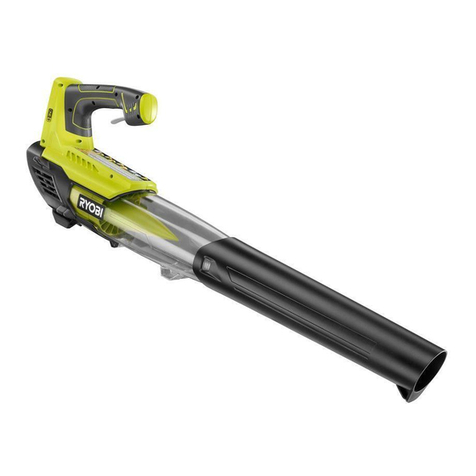
Ryobi
Ryobi 18 Volt One+ Series Operator's manual
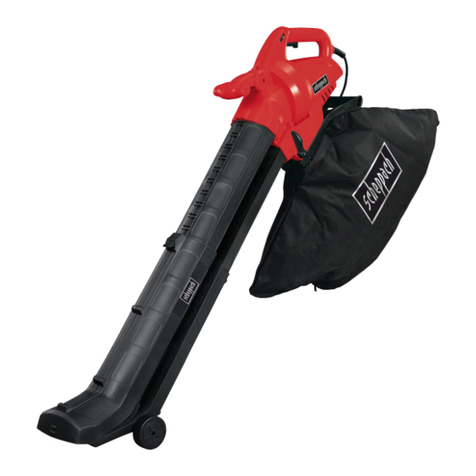
Scheppach
Scheppach LBH3800E Translation from the original instruction manual

Fimap
Fimap FS700 B Use and maintenance manual

GreenWorks
GreenWorks 2402202 Operator's manual

diversey
diversey Taski balimat 6500 instruction manual
